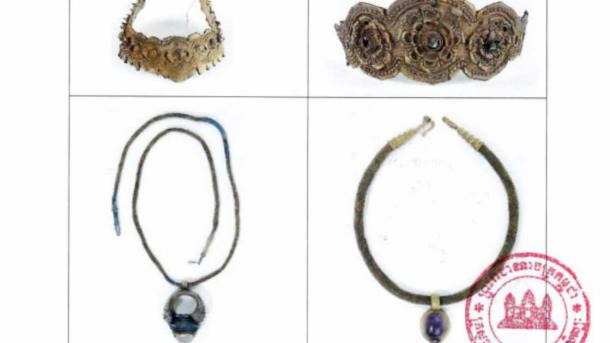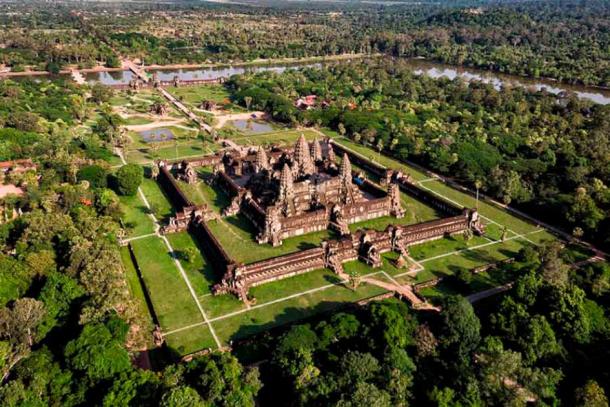
Centuries-Old Stolen Khmer Jewel Collection Returned to Cambodia
A huge cache of stolen crown jewels dating back to Cambodia’s legendary Khmer (Angkorian) Empire resurfaced in London last summer, and have now been returned to Cambodia, the BBC has announced. Some of the jewels even predate the start of the Khmer Empire, which lasted from the 9th through to the 15th centuries AD.
The collection of priceless pilfered items once belonged to the British illicit antiquities dealer and collector Douglas Latchford, who died in 2020 before he could be tried and convicted of his many alleged crimes against Cambodian culture. Ever since he passed away authorities have been searching for the remains of his vast collection of Khmer artifacts, some of which were obtained legally, but many of which were looted from sacred temples and sold on the black market over the course of many decades.
The exotic jewelry, which once belonged to Khmer aristocrats who ruled over a vast Southeast Asian kingdom, has already been returned to Cambodian authorities in Phnom Penh. The plan is to put these precious items on display at their national museum, where Cambodian citizens will be able to see the dozens of intricately crafted artifacts from their country’s glorious past for the very first time.
After Latchford’s death, his family members promised to cooperate with British authorities in the search for the antiquities collector’s vast holdings, many of which were held at secret or private locations. When Brad Gordon, the head of Cambodia’s antiquities theft investigative team, traveled to London in the summer of 2022, he became the first person representing that nation to see the crown jewels, some of which were more than 1,400 years old.
- The Crocodile Stone: Is This a Grisly Artifact of Human Sacrifice?
- Cambodia Demands British Museums Return Stolen Khmer Artifacts

The trove includes crowns and other treasures from the Angkor period, which ran from the ninth to the 14th century AD. (Cambodian Ministry of Culture and Fine Arts/Handout via Xinhua)
"I was driven by a representative of the Latchford family to an undisclosed location,” he told the BBC. “In the parking lot was a vehicle with four boxes inside. I felt like crying. I just thought - wow - the crown jewels of an ancient Cambodian civilization packed into four boxes in the back of a car."
Inside the boxes were 77 well-preserved pieces of gold and mineral-encrusted jewelry, including earrings, crowns, necklaces, bracelets and belts. One of the more notable items was a solid gold bowl, likely used as a rice bowl by Angkorian royalty, that probably dates to the 11th century, a time when the Khmer Empire was at the peak of its wealth and power.
One of the crowns was estimated to be from the pre-Khmer period, and may have been manufactured by skilled artisans as early as the seventh century AD. Some of the items, such as a small sculpture made in the shape of a flower, have no obvious purpose and therefore might have been part of a larger piece or assembly at one time.
Interestingly, some of the jewelry had been seen before. Pictures of five of the items had been included in a book called “Khmer Gold” that Douglas Latchford co-wrote in 2008 with Emma C. Bunker, a consultant for the Denver Museum of Art in the United States who worked closely with Latchford for decades. According to Ashley Thompson, a professor of Southeast Asian Art at SOAS University of London, Latchford used this and other books he authored to cast a veneer of legitimacy on the illicit items he absorbed into his vast collection of Khmer cultural treasures.
"Publishing these materials, inviting other scholars to contribute and comparing the items to museum pieces was a way of validating them and associating them with known materials already in museums and effectively enhancing their value," she explained.
- Walking in Shadows of Serenity: The Great Sacred City of Angkor Thom
- Jayavarman II: Self-Proclaimed God-King of the Khmer Empire

Some of the gold collection was returned to Cambodia last Friday. (Cambodia Ministry of Culture and Fine Arts)
The Khmer Empire and Douglas Latchford’s Obsessive Quest to Own its Treasures
During the 600-plus year reign of the Angkorian emperors (the Khmer or Angkorian Empire was founded in 802 and dissolved in 1431), Cambodia’s spiritual and material culture reached impressive heights. The empire embraced both Hinduism and Buddhism, which added depth and richness to its religious art, architecture and iconography.
The gigantic temple complex at Angkor Wat, which dates back to the 11th century, was the empire’s most celebrated and enduring achievement, and to this day it remains the world’s largest religious site. Many of the newly recovered jewels can be matched with stone carvings on the walls at Angkor Wat, suggesting that perhaps it came from there.
Looting of Cambodian antiquities was common during the French colonial period (1863 – 1953), and the Angkor Wat temple complex was heavily targeted at this time. Many more temples were broken into and robbed during the tumultuous and murderous Khmer Rouge era of the 1970s, when thousands of stolen artifacts were sold through dealers in Hong Kong and Thailand to private collectors and museums in the United States and Europe.
It was in the latter period that the Englishman Douglas Latchford began to amass his impressive collection of Khmer Empire rarities, which included a significant number of Hindu and Buddhist sculptures and statues.
“The sculpture and architecture created by the Khmer to honor their gods and their rulers are among the major artistic masterpieces of the world,” he wrote in 2004 in “Adoration and Glory,” the first of three books he co-authored with Emma Bunker about his collecting habits.
Latchford’s collection of art and artifacts from the most famous period of Cambodian history was one of the world’s largest, and in the early years of his public career he was recognized as a legitimate collector who was doing his best to preserve and protect ancient historical artifacts.

The majestic site of Angkor Wat. (R.M. Nunes/ Adobe Stock)
But all of this began to change in the 2000s, when scrutiny of Latchford’s behavior increased and authorities became more and more convinced he was involved in the illegal antiquities trade. His partner Emma Bunker also came under suspicion, and it is now believed that many of the Southeast Asian artifacts she helped the Denver Art Museum acquire over the course of her long career were obtained through black market sources (Bunker passed away in 2021 without being officially charged of any crimes).
It wasn’t until 2019 that authorities in the United States finally had enough evidence to indict Latchford for antiquities theft. But the 88-year-old cheated justice by dying before he could be put on trial, and his sudden departure left the authorities scrambling to locate all of his ill-gotten artifacts.
Unwilling to be prosecuted themselves, Latchford’s family members decided to cooperate with law enforcement. They sent five stone and bronze artifacts back to Cambodia in 2021, but turning over the crown jewel collection is their most significant and meaningful action so far.
Cambodia to Art World: “You Stole Our Legacy, Now Send it Back!”
As the investigation into Latchford’s illicit wheeling and dealing continues, the Cambodian government is celebrating the return of the Khmer Empire crown jewels.
"The repatriation of these national treasures opens a new era of understanding and scholarship about the Angkorian empire and its significance to the world," said Cambodian Minister of Culture and Fine Arts Phoeurng Sackona, in a statement released by her agency.
The Minister also called on private collectors, museums and educational institutions to carefully examine their stocks, to make sure they, too, aren’t holding valuable items that were looted from Cambodia’s scores of ancient temples.
"We consider such returns as a noble act, which not only demonstrates important contributions to a nation's culture, but also contributes to the reconciliation and healing of Cambodians who went through decades of civil war," she said.
Top image: A crown from the Khmer Crown jewel collection that has been returned to Cambodia. Source: Cambodian Minister of Culture and Fine Arts
By Nathan Falde
















Comments
Returning treasures to unstable regimes is simply guaranteeing they get lost again. Far better to be safe in public/private collections in stable countries!
From stardust I was born, to stardust I shall return
The field of Archaeology obviously began as nothing more than grave-robbing (petty theft), but was later transformed into the art of deception as well as a collector's hobby of the ‘elites’ (i.e., tyrants).
But beyond that, the big question is, how much of these finds were pre-Ice Age/Atlantean era? Was the so-called ‘Bronze Age’ really just the era of the big finds? How many metal objects have been drilled into and uranium-radio-metrically core-tested for true dating?
Nobody gets paid to tell the truth.
I think returning these items is the right thing to do. Long gone are the days when priceless objects from a culture’s history can be stolen for use in a museum, or just to languish in drawers or on shelves.
These priceless artifacts belong with the culture from which they came, with the caveat that they maintain them properly and not sell them to private individuals.